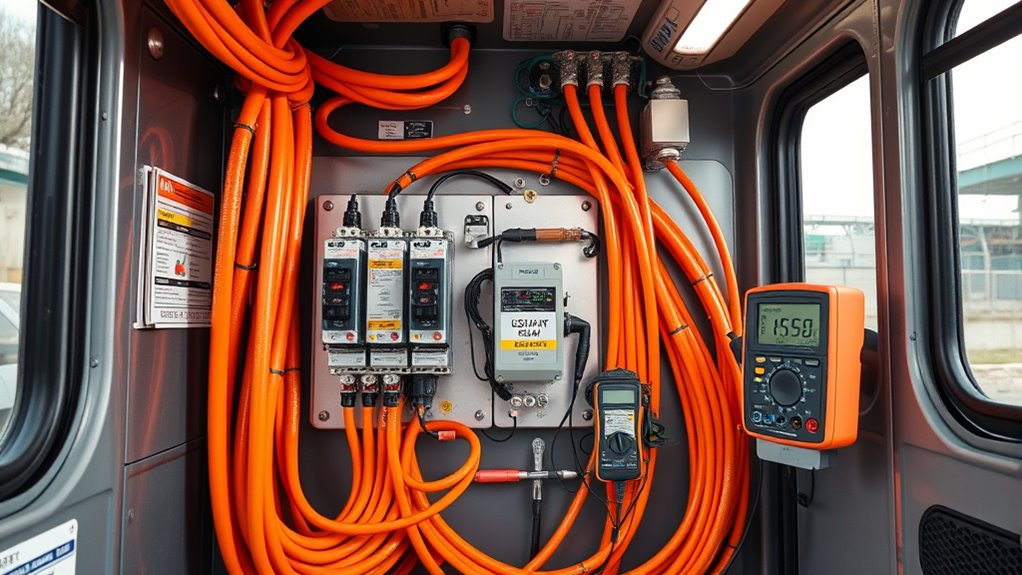High-voltage safety circuits in electric buses use insulation barriers to physically separate high-voltage components from accessible parts, preventing accidental contact. Relays and fault detection systems monitor electrical conditions constantly, quickly disconnecting power during faults to protect personnel and equipment. This layered approach guarantees system reliability and safety during normal operation and emergencies. If you’d like to explore how these components work together, more detailed insights are just ahead.
Key Takeaways
- Isolation barriers physically separate high-voltage components from accessible areas to prevent accidental contact.
- Relays automatically disconnect high-voltage systems during faults to protect personnel and equipment.
- High-voltage safety circuits continuously monitor electrical integrity and activate protective measures when anomalies occur.
- Regular testing of relays and insulation ensures reliable operation and system safety in electric buses.
- Integrated safety systems combine isolation and relay mechanisms to maintain high-voltage safety during normal and fault conditions.

High-voltage safety circuits are essential for protecting personnel and equipment from the dangers of high-voltage electrical systems. When working with electric buses, understanding how insulation barriers and fault detection mechanisms work together is crucial for maintaining safety and reliability. Insulation barriers are designed to physically separate high-voltage components from accessible parts, reducing the risk of accidental contact. These barriers are made from durable insulating materials that can withstand electrical stress and environmental conditions, ensuring that high-voltage parts stay isolated during normal operation and faults. Proper insulation barriers not only prevent direct contact but also contain electrical arcing, which can occur if insulation degrades or a fault develops.
Fault detection plays a vital role in high-voltage safety circuits by continuously monitoring the system for abnormal conditions. When a fault occurs—such as a short circuit or insulation breakdown—the detection system quickly identifies the issue and triggers protective measures. This rapid response minimizes potential damage to the vehicle’s electrical components and reduces the risk of injury to maintenance personnel. Fault detection is often integrated with circuit breakers or relays that disconnect power sources immediately upon detecting a fault, preventing the fault from escalating into more severe problems. Combining fault detection with robust insulation barriers creates a layered safety approach, ensuring that high-voltage energy is contained and that faults are swiftly addressed.
In electric buses, these safety features are especially critical because of the confined spaces and the high energy involved. The system’s design must prioritize clear, reliable insulation barriers, which are regularly inspected and maintained to prevent deterioration. When faults are detected, the safety circuits activate protective devices, isolating the affected section of the high-voltage system and preventing the fault from spreading. This process not only protects maintenance teams but also ensures the bus remains safe for passengers and operators. By integrating insulation barriers with fault detection technology, you create a resilient safety framework that minimizes downtime and enhances overall system reliability.
Furthermore, regular testing and maintenance of these safety components are essential to ensure they function correctly when needed. Ultimately, high-voltage safety circuits in electric buses depend on the synergy between physical separation through insulation barriers and intelligent fault detection systems. Staying vigilant about these safety measures helps you prevent accidents and maintain the integrity of the electrical system. Proper implementation and regular testing of these components are key to ensuring that high-voltage energy remains safely contained, providing peace of mind as you operate and service electric buses.
Frequently Asked Questions
How Do Safety Circuits Handle Fault Conditions?
When a fault occurs, safety circuits detect it through fault detection mechanisms that monitor for abnormal conditions. You should guarantee circuit redundancy so that if one path fails, another can maintain safety. The system quickly isolates the faulty section, preventing harm or damage. By continuously monitoring and isolating faults, safety circuits help keep electric buses secure, reliable, and compliant with safety standards, protecting both passengers and equipment effectively.
What Are the Maintenance Challenges for High-Voltage Relays?
Ever wondered what makes maintaining high-voltage relays challenging? You’ll often face contact degradation and coil fatigue, which can lead to unreliable operation. Regular inspections are essential to catch pitting or corrosion early. You should also monitor coil resistance for signs of fatigue. Ensuring proper cleaning and avoiding excessive switching cycles help extend relay life. Staying proactive in maintenance keeps your safety systems functioning reliably.
How Are Safety Standards Updated for Electric Buses?
You stay compliant by regularly updating safety standards through industry and government guidelines. You focus on battery management and insulation testing to guarantee safety. Manufacturers and regulators collaborate to revise protocols, incorporating new technology and lessons learned. You must stay informed about these updates, implement changes promptly, and conduct ongoing training. This proactive approach helps protect passengers and maintenance personnel while ensuring your electric bus meets the latest safety requirements.
What Are the Cost Implications of Implementing Isolation Systems?
Thinking about safety costs is like planning for a spaceship launch—every detail matters. Implementing isolation systems increases initial expenses, but a thorough cost analysis helps you balance safety with budget planning. While upfront costs might seem high, they reduce long-term risks and repair costs. You save money over time by avoiding accidents and maintaining compliance. So, investing in isolation systems is a smart move that pays off in safety and savings.
How Do Safety Circuits Impact Vehicle Weight and Design?
Safety circuits add some weight to your vehicle due to additional components like relays and insulation. They influence your vehicle’s design considerations by requiring space for these systems, which can affect layout and weight distribution. While necessary for safety, you need to balance these factors to optimize vehicle performance and efficiency. Proper integration guarantees safety without compromising your bus’s weight limits or overall design integrity.
Conclusion
You might think that high-voltage safety circuits are just technical details, but they truly safeguard lives on electric buses. By ensuring proper isolation and relay functions, you prevent dangerous electric shocks and fires. It’s not just a theory—it’s proven that these safety measures save lives every day. Trust in these systems, because behind every safe ride is a commitment to protecting you and everyone on board. Safety isn’t optional; it’s essential.









